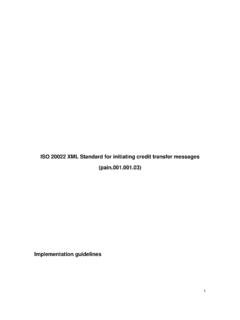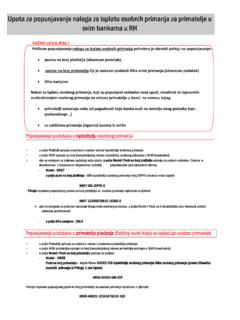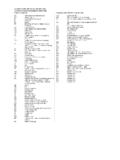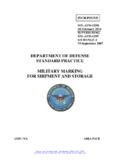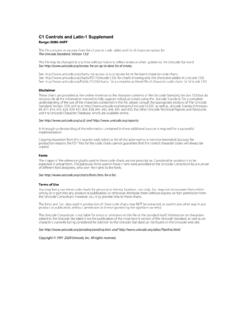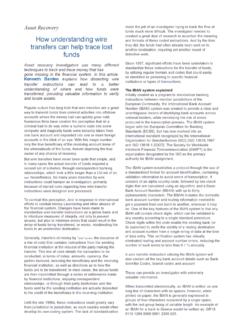Transcription of Client Guidelines for accepting the pain.002.001.03 XML ...
1 1 Client Guidelines for accepting the XML message on the status of the payment order from the message Implementation Guidelines 2 CONTENTS 1. OVERVIEW OF THE DOCUMENT VERSION .. Error! Bookmark not defined. 2. INTRODUCTION .. Error! Bookmark not defined. 3. SCOPE OF IMPLEMENTATION .. Error! Bookmark not defined. 4. ABBREVIATIONS .. Error! Bookmark not defined. 5. VALIDATION OF THE MESSAGE .. 4 6. SPECIFICATION OF THE MESSAGE FORMAT .. 5 a. Structure of the message .. 7 7. DESCRIPTION OF DATA STRUCTURE IN THE MESSAGE .. 9 3 1. OVERVIEW OF THE DOCUMENT VERSION Version Status / Change Date Publication of the Guidelines Implementation date change 4 2. INTRODUCTION The Guidelines describe the manner of application and implementation of the XML message which is provided by the payment service provider (PSP) to the payment service user (PSU) as information on the status of the payment order (Customer Payment Status Report) initiated in the message (Customer Credit Transfer).
2 Application of the message is arranged by the PSP with the PSU. The Guidelines are applicable from 1 April, 2016. The Guidelines have been prepared through mutual cooperation between the banking community and the Financial Agency (FINA). The Guidelines are publicly available at: and on the websites of the Croatian Banking Association, commercial banks registered in the Republic of Croatia, the Croatian Chamber of Economy and the Financial Agency. The Guidelines have been compiled with special attention to ensure accuracy of information. However, the Croatian banking community and the Financial Agency are not responsible for any possible damage or errors which could occur as a consequence of misinterpretation of the information contained in the Guidelines . For further information, PSUs may contact the PSP in which they maintain a transaction account. 3. SCOPE OF IMPLEMENTATION These Guidelines describe the use of the message for rejected (Reject-status RJCT) transactions which have been initiated as payment orders in the message.
3 Other information on the payment status from the message are arranged by the PSU with their PSP and they are not the subject of these Guidelines . Payment orders can be rejected after the control by the PSP of the debtor or the clearing house. The structure and contents of the message are presented in tabulatory form within these Guidelines . Reference documents are the same as with the message. 4. ABBREVIATIONS PSP Payment Service Provider (bank) PSU Payment Service User SEPA Single Euro Payments Area SCT SEPA Credit Transfer EPC European Payment Council ISO International Standardization Organization CSMs Clearing and Settlement Mechanisms (clearing houses) XSD schema describes the structure of the XML message 5. VALIDATION OF THE MESSAGE The message is validated according to the XSD schema for published and available at: 5 The structure and content of data in the message have been defined according to the Common Global Implementation (CGI) CustomerPayment StatusReport recommendations and national qualities specific for the Republic of Croatia.
4 The lists of codes which are not embedded in the XSD schema ( , country code lists, currency code lists, purpose code lists, etc.) are available at: Rejection codes in the message Rejection codes are found in the ExternalStatusReason1 Code ISO list, available at: An unofficial translation of the ExternalStatusReason1 Code ISO list has been published at: The user of these Implementation Guidelines undertakes to track the changes of the published lists of codes from the ExternalStatusReason1 Code list. 6. SPECIFICATION OF THE pain . MESSAGE FORMAT Index Mult Mandatory/Optional (M/O) ISO element name ISO XML tag (<XML Tag>) Format Element use and meaning Index element codes of the message are marked as in the ISO 20022 XML standard Multi rule the first data indicates the obligatoriness of occurrence of message elements, and the second data indicates the number of allowed repetitions Example of the rule: [ ] The element is optional and it can be specified once or never.
5 [ ] Indicates that the element is optional and can be specified once or n number of times. [ ] The element is mandatory and can be specified only once. [ ] The element is mandatory and can be specified once or n number of times. Message elements are defined by their hierarchical structure. If data in a sub-element is entered, it is mandatory to specify the elements of a higher hierarchical level. If sub-elements are marked with {Or .. Or}, it is possible to use only one of them. When an optional element is used, and it contains sub-elements (of a lower hierarchical level), the rule of populating that element (M/O) is mandatory and must be respected. Mandatory/Optional (M/O) the rule of use, mandatory or optional use ISO element name the name of the message element is given in English as defined in ISO 20022 XML standard, with a translation into Croatian. The element can contain sub-elements, which are shifted to the right and marked with an additional + sign.
6 : ++ Debtor +++ Name ISO XML tag (<XML Tag>) XML element tag : <Dbtr> Debtor/Payer. Note: if using the tag, the corresponding element data may not be empty and at least one character must be entered. Format the element format is described, : Text, Code Element use and meaning describes the use and meaning of an individual field 6 Description of data formats Examples of data format descriptions: Format Format description Description Dates ISODate ISO date in the form of YYYY-MM-DD , where YYYY is the year, MM the month, DD the day. Example: 2010-10-04 ISODateTime ISO date and time YYYY-MM-DDThh: , where YYYY is the year, MM the month, DD the day, hh the hour, mm the minute, ss the second, sss the hundredth of a second. Example: 2010-10-04T08:35 The amount and number CurrencyAndAmount number: max 18, decimals: max 5 Currency code. [A-Z]{3,3} Currency code is stated in the ISO three-letter format next to the Ccy attribute.
7 The amount consists of 18 characters (numbers). An integer has a maximum of 13 characters, and a decimal number a max of 5. The decimal separator is the point. It is not allowed to enter a negative amount. Note: the rule for populating the Amount field is described by element Example: <Ccy= EUR > Numeric [0-9]{1,15} A number can have a maximum of 15 places. Example: 123456789012345 DecimalNumber number: max 18, decimal places: max 17 Maximum 18 places, of which a maximum of 17 numbers for decimal places. The decimal separator is the point. Example: Note: for a credit transfer a maximum of 2 numbers for decimal places may be used. Number number: max 18, decimal places: 0 Maximum 18 places, no decimal places. Example: 123456789987654321 Text Text The text can use characters of the Latin alphabet (a b c d e f g h i j k l m n o p q r s t u v w x y z A B C D E F G H I J K L M N O P Q R S T U V W X Y Z For national transactions the , , , , , , , , , characters may also be used 0 1 2 3 4 5 6 7 8 9 / - ?)
8 : ( ) . , ' + space Rule: Word-spacing and - must not be used in the first place of the record in the XML element/field. A slash (/) must not be used at the beginning or end of the data, nor twice in a row. Text Max3 Maximum length is 3 places. Example: 112 Text Max35 Maximum length is 35 places. Example: Payment operations street Identifier 7 Format Format description Description BICI dentifier [A-Z]{6,6}[A-Z2-9][A-NP-Z0-9]([A-Z0-9]{3 ,3}){0,1} BIC-type identifier (Bank Identifier Code), which has to have 8 or 11 characters. Example: AAAAHR2X or AAAAHR2 XXXX BEII dentifier [A-Z]{6,6}[A-Z2-9][A-NP-Z0-9]([A-Z0-9]{3 ,3}){0,1} BEI-type identifier (Business Entity Identifier). IBAN2007 Identifier [A-Z]{2,2}[0-9]{2,2}[a-zA-Z0-9]{1,30} IBAN account in electronic form. Example: HRXX77777779999999999 Code CountryCode [A-Z]{2,2} ISO two-letter country code. Example: HR CurrencyCode [A-Z]{3,3} ISO three-letter currency code. Example: EUR For national payments in HRK and EUR, diacritic characters (.)
9 May be used, while in cross-border payments, they are not used. Names of XML message elements, which are originally specified in English, are in these Guidelines also specified in Croatian and supplemented with a description in Croatian. Only those elements which are described in these Guidelines are used in the message. a. Structure of the message A message/file containing the XML message has the following structure: <?xml version=" " encoding="UTF-8" standalone="no" ?> <Document xmlns="urn:iso:std:iso:20022:tech: " xmlns:xsi=" " xsi:schemaLocation="urn:iso:std:iso:20022:tech: "> <CstmrPmtStsRpt> message </CstmrPmtStsRpt> </Document> The message consists of 3 sets of data: A. The header or the leading record (Group Header) Set of data which is mandatory and occurs only once in the message. Contains information such as the Message Identification Code (MessageIdentification), the Date and Time of Creation (CreationDateAndTime).
10 B. Information and status of the original message (Original Group Information and Status) message level Set of data which is mandatory and occurs only once in the message. It also contains data on the original message (Original message identification code OriginalMessageIdentification, Original message name OriginalMessageNameIdentification). Information on the rejection status (Reject) is provided only if the entire message is rejected, in which case it contains the reason for rejection. 8 C. Information and status of the original group order/payment order (Original Payment Information And Status) group order/individual payment order level Set of data which is optional and which is repeated. Contains data from the original group order or from the individual payment order from the message. Information on the rejection status (Reject) is provided on the level of the group order or on the level of the individual payment order if the entire group or an individual payment order (orders) from the group order is rejected, in which case it contains the reason for rejection.

